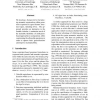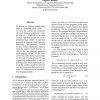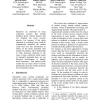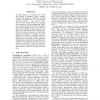ACL
2001
14 years 25 days ago
2001
We develop a framework for formalizing semantic construction within grammars expressed in typed feature structure logics, including HPSG. The approach provides an alternative to t...
ACL
2001
14 years 25 days ago
2001
We consider the question "How much strong generative power can be squeezed out of a formal system without increasing its weak generative power?" and propose some theoret...
ACL
2001
14 years 25 days ago
2001
We present two language models based upon an "immediate-head" parser -our name for a parser that conditions all events below a constituent c upon the head of c. While al...
ACL
2001
14 years 25 days ago
2001
This paper addresses the issue of designing embodied conversational agents that exhibit appropriate posture shifts during dialogues with human users. Previous research has noted t...
ACL
2001
14 years 25 days ago
2001
The RAGS proposals for generic specification of NLG systems includes a detailed account of data representation, but only an outline view of processing aspects. In this paper we in...
ACL
2001
14 years 25 days ago
2001
Educators are interested in essay evaluation systems that include feedback about writing features that can facilitate the essay revision process. For instance, if the thesis state...
ACL
2001
14 years 25 days ago
2001
We address the issue of on-line detection of communication problems in spoken dialogue systems. The usefulness is investigated of the sequence of system question types and the wor...
ACL
2001
14 years 25 days ago
2001
For ambiguous sentences, traditional semantics construction produces large numbers of higher-order formulas, which must then be -reduced individually. Underspecified versions can ...
ACL
2001
14 years 25 days ago
2001
We aim at finding the minimal set of fragments which achieves maximal parse accuracy in Data Oriented Parsing. Experiments with the Penn Wall Street Journal treebank show that cou...
ACL
2001
14 years 25 days ago
2001
In this paper, we compare the relative effects of segment order, segmentation and segment contiguity on the retrieval performance of a translation memory system. We take a selecti...




